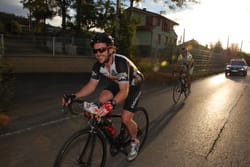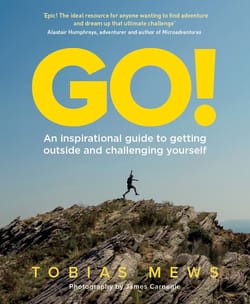As creatures of habit, we like to know how long something will take. But in contrast to a race, which is often limited by distance, this orienteering-style challenge is about squeezing in as much as you can within 60 minutes, all while exploring your local neighbourhood.
RULES
1. Your time is limited to 60 minutes.
2. You decide how you’re going to spend your time – ‘collecting’ monuments, running as far as you can, juggling while running, have another moment.
or even running between Starbucks cafés.
KIT
• Smartphone with 3G connection
• Running shoes
• GPS watch to track route and keep track of time
For many of us, especially those with children, the concept of time can have no meaning. Sometimes it feels as if we’ve stepped through a wormhole in which hours pass in the same way that minutes do. Which is why you’ll appreciate this challenge. With 1,440 minutes in a 24-hour time period, there’s no reason you can’t use 60 Minutes of your day for something new – whether it’s before or after work or even during your lunch break. And what’s more, it’s ideal to do with friends and family.
And the key to all of this is a map. That folded piece of paper puts us all on a level playing field where fitness levels can be offset by the ability to navigate. As the saying goes, ‘It doesn’t matter how fast you are if you’re going in the wrong direction’.
The first stage is to look at what’s around you and see if there’s a pattern. Are you in a city with lots of churches, like Naples? Or perhaps you live in a place such as Madrid, where there are dozens of statues? Essentially it’s a case of joining the dots and seeing if a pattern emerges.
WhenI lived in London,I was intrigued by the Blue Plaques attached to the side of various homes and buildings. On my runs, I’d stop to read them, learning that a famous poet, author, politician or soldier had lived in that very house. If I had my phone with me, I’d take a photo, to remind me to learn more about the person when I got home. ‘I wonder how many Blue Plaques I can visit in an hour?’ I thought to myself.
For the amateur historians among us, the commemorative plaques offer endless possibilities in which to learn something new about your area. In Paris you could learn about its remarkable history by looking for the Histoire de Paris oar-shaped plaques, designed by Phillipe Starck. Should you happen to be in Rome, you could try to visit as many marble wall plaques as possible. These were a trend from the late nineteenth century and, like London’s Blue Plaques, they commemorate the lives of interesting people who have lived in that property. Or if you’re passing through Berlin, there are more than five thousand cobblestone- sized memorials, called Stolpersteine (literally ‘stumbling stones’), each laid on pavements outside the homes of ‘a single victim of Nazism’.
After a bit of research, I found a map that showed where many of the Blue Plaques are situated. But with more than two thousand to choose from, I decided to limit myself to a postcode, which in my case was London’s SW11. Of course it could be an arrondissement, canton, or any other administrative area with a boundary.
You’re not just limited to historical plaques. In a bid to generate interest in a major film being released, some production companies work alongside tourism bodies by laying out temporary statues around a city. For example, when the irrepressible Paddington Bear was appearing in cinemas, more than fifty
Paddington statues were scattered around London. The same thing happened for the films celebrating Shaun the Sheep and the Big Friendly Giant, making it the perfect excuse to drag your family with you on an adventure. So keep an eye on the big screen – you never know what will happen.
I’ve been running around my local borough for many years, although I’ve been a slave to the same old routes. Armed with a map and my GPS-enabled smartphone as a backup, I now find myself darting down roads that were otherwise invisible to me. From quaint cobblestone mews streets to ordinary-looking high streets hiding interesting people, I start to see these streets with fresh eyes. With some of the eminent residents dating back three to four hundred years, my imagination runs wild as I try to picture what it must have been like back then. So much has changed.
I hardly notice the minutes pass, until the clock on my phone indicates my time is up. I’ve ‘collected’ 26 plaques, covered 11 kilometres, discovered areas I hitherto haven’t known existed and in the process learned so much about my area, including the fact that I live less than a mile from a former prime minister. But the most salient fact I learned is that the only thing we’re limited by is our imagination.




